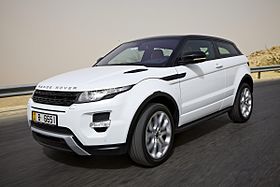Land Rover Evoque
| Range Rover Evoque | |
|---|---|
 |
|
| Overview | |
| Manufacturer | Land Rover |
| Production | July 2011–present |
| Assembly |
Halewood, United Kingdom (HB&A) Changshu, China Pune, India Itatiaia, Brazil |
| Designer | Gerry McGovern |
| Body and chassis | |
| Class | Compact luxury crossover SUV |
| Body style | 5-door crossover SUV 3-door crossover SUV 2-door Convertible |
| Layout | Transverse front-engine, front-wheel-drive or four-wheel-drive |
| Related |
Land Rover Freelander 2 Land Rover Discovery Sport |
| Powertrain | |
| Engine | 2.0 L EcoBoost I-4 (t/c petrol) 2.0 L Ingenium I-4 (t/c diesel) 2.2 L Duratorq I-4 (t/c diesel) |
| Transmission | 6–speed Getrag M66EH50 manual 9-speed ZF Friedrichshafen 9-HP automatic |
| Dimensions | |
| Wheelbase | 2,660 mm (104.7 in) |
| Length | 3-door: 4,371 mm (172.1 in) 5-door: 4,371 mm (172.1 in) |
| Width | 1,900 mm (74.8 in) |
| Height | 3-door: 1,605 mm (63.2 in) 5-door: 1,635 mm (64.4 in) |
| Kerb weight | 1,595–1,700 kg (3,516–3,748 lb) |
The Range Rover Evoque is a compact luxury crossover SUV produced by the British manufacturer Land Rover, part of Tata's Jaguar Land Rover group. It has been produced since July 2011 in three and five-door versions, with both two-wheel and four-wheel drive. The Evoque is designed to appeal to urban buyers and meet requirements for lower CO2 emissions and fuel economy. The production vehicle is similar to the Land Rover LRX concept, which was unveiled at the North American International Auto Show in January 2008. The Evoque, which was designed to add a more affordable model to the 'high-end' classic Range Rover range, was received positively by the automotive press for retaining the features, amenities, and off-road capabilities of a traditional Range Rover in a smaller package. Land Rover sold nearly 88,000 units of the Evoque in its first year of production.
The Evoque was developed from the LRX concept vehicle with the goal of producing a smaller more environmentally conscious and more affordable vehicle. The size of the LRX complemented a wide array of efficiency improving technologies in the form of Land Rover’s e_Terrain technologies. These included biofuel compatibility, lightweight construction materials and technologies such as the removable carbon composite roof panels, regenerative brakes, a stop-start system, and the ERAD (electric rear axle drive) parallel hybrid powertrain system.
The ERAD system could propel the LRX to speeds of up to 20 mph (32 km/h) before the engine was started by an integrated starter generator as part of the stop-start system. ERAD was designed to reduce CO2 emissions by an average of 20 percent under the NEDC test cycle and was expected to offer another 10 percent reduction in extra-urban driving situations while also optimising the off-road ability of the vehicle. Land Rover aimed to achieve 120 g/km CO2 emissions and fuel economy of 60 mpg‑imp (4.7 L/100 km; 50 mpg‑US) on the European combined cycle with an efficient 2.2-litre turbodiesel engine. The engine would become the only four-cylinder vehicle in the Range Rover lineup.
...
Wikipedia
